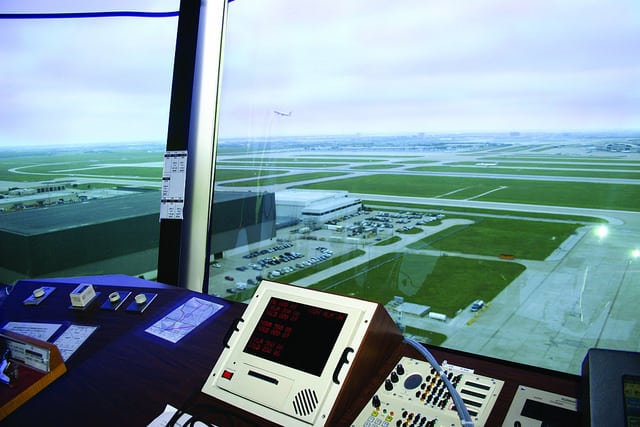[Avionics Magazine 01-06-2017] The FAA is leading an initiative that seeks to make the federal government’s existing use of up to 793 existing long- and short-range air surveillance radar systems more operationally and financially efficient. By 2024, the FAA, along with several other federal government agencies, hopes to be able to auction off a portion of the radio communications spectrum used by those agency radars to private industries and telecommunications companies that want to use it for Internet and cellular data communications services.

Dallas/Fort Worth (DFW) air traffic control tower. Photo: National Air Traffic Controllers Association (NATCA).
On Tuesday, Jan. 3, the FAA formally issued a Request for Information (RFI) for the Spectrum Efficient National Surveillance Radar (SENSR) program. The SENSR program was created as a result of the Spectrum Pipeline Act of 2015, where lawmakers tasked government agencies such as the FAA with submitting a plan to free 30 MHz of spectrum below 3.0 GHz in an auction that must take place by 2024, according to a media briefing lead by the FAA’s SENSR program manager, Rebecca Guy. In the SENSR RFI, the FAA-lead government agency is looking to assess the practicality of freeing up spectrum in the 1300-1350 MHz range to be reallocated for shared federal and nonfederal uses by acquiring new radar surveillance capabilities.
Officials from the Department of Defense (DOD), Department of Homeland Security (DHS) and the National Oceanic and Atmospheric Administration (NOAA) are part of the FAA-led SENSR initiative. The four agencies are considering the creation of a new system that would consolidate legacy radars that are currently used by each individual agency for different purposes. Existing radar systems being considered for consolidation by all four agencies include Airport Surveillance Radar (ASR) models 8, 9, and 11; military equivalent Army/Navy-Ground Position Navigation (GPN) Radars; Common Air Route Surveillance Radar (CARSR); and Air Route Surveillance Radar Model 4 (ARSR), all used by the FAA, DOD and DHS for commercial and military long- and short-range aircraft operations.
Additionally, Terminal Doppler Weather Radar (TDWR) and Weather Surveillance Radar-88 Doppler (NEXRAD) are under consideration for SENSR as well. The FAA uses TDWR to monitor National Airspace System (NAS) weather. NOAA and several other government agencies use NEXRAD to detect precipitation and atmospheric movements.
In the RFI, the FAA notes that the relocation of existing radars in Radio Frequency (RF) spectrum can be opened up for commercial auction to offset the cost of modifications, relocations and replacement solutions. Effectively, the agency is looking to consolidate its use of “non-cooperative” radar technology, which does not include Automatic Dependent Surveillance Broadcast (ADS-B) or its Mode S beacon detecting system, along with radar surveillance used by the other above mentioned agencies into one system. The existing spectrum currently being used by the radars that are to be consolidated under SENSR will be commercially auctioned off.
“SENSR is needed to ensure the safety and security of the National Airspace System (NAS), to provide air domain awareness for defense, provide non-cooperative surveillance for multiple enforcement agencies, and to mitigate hazards to other aircraft of single aircraft avionics failures. SENSR solutions may possibly provide a cost-effective replacement for existing surveillance and weather radars that free up RF spectrum and support many cross-agency users,” FAA notes in the RFI.
Between now and 2018, the FAA wants to continue discussions with the industry to establish and define the type of system that can achieve consolidation of the legacy aircraft and weather surveillance radars, to provide the same capabilities that the radars provide today, while making it technologically feasible to then conduct a commercial auction for 30 MHz of spectrum below 3.0 GHz by 2024.
“Where Congress is on this, and what has been coming forward, is incentivizing agencies to see if we can be more spectrum efficient. What we looked at from a DOD, DHS and NOAA perspective; is there a way we can come together and potentially consolidate or have a system of systems radar technology,” said Guy.
The existing Jan. 1, 2020, ADS-B mandate is one of the reasons the FAA is able to consider the consolidation of its current use of short- and long-term ground-based radar surveillance technology, as the FAA is making ADS-B its primary aerial surveillance technology moving forward. However, the FAA, DOD and DHS will continue to rely on ground-based surveillance as a backup, which is why SENSR is necessary.